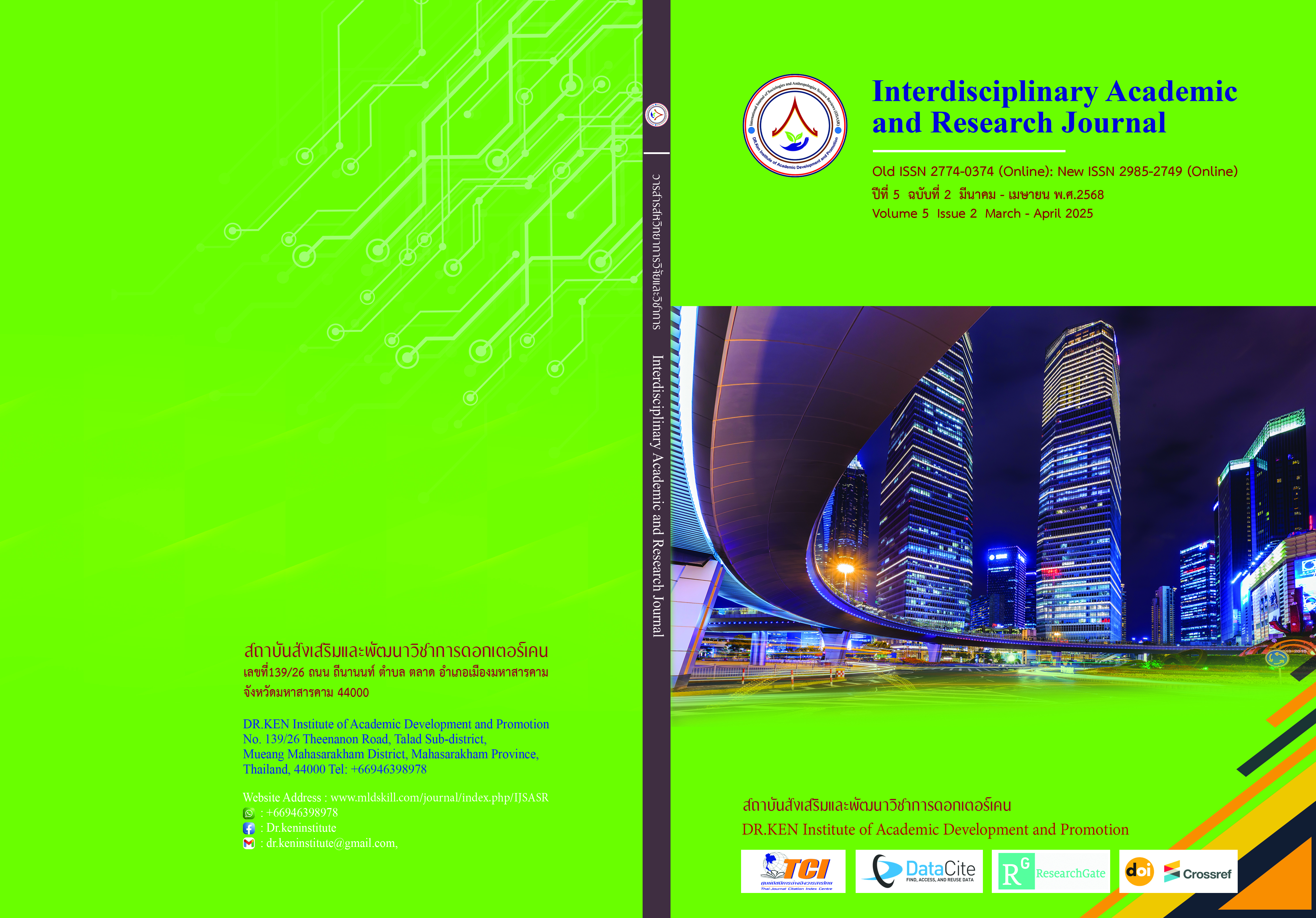Students’ Online Learning Behavior: A Case Study of the College of Politics and Governances of Mahasarakham University
DOI:
https://doi.org/10.60027/iarj.2025.282172Keywords:
Behavior, Satisfaction, Online LearningAbstract
Background and Aims: In the current era, online communication technology has a direct impact on the education system. Information technology is closely related to the collection of data, dissemination of knowledge, high-speed communication, and the presentation of information through various media. The researcher is interested in studying the online learning behaviors of students at the Faculty of Political Science and Public Administration, Mahasarakham University. The objectives of this study are: To investigate the behaviors of students during online instruction at the Faculty of Political Science and Public Administration, Mahasarakham University. To assess the satisfaction levels of students regarding online instruction at the Faculty of Political Science and Public Administration, Mahasarakham University. To identify the problems encountered during online instruction at the Faculty of Political Science and Public Administration, Mahasarakham University.
Methodology: This research, titled “Studying Online Learning Behaviors of Students at the Faculty of Political Science and Public Administration, Mahasarakham University,” is a survey research aimed at studying the behaviors, satisfaction, and problems related to the online learning system of students at the Faculty of Political Science and Public Administration. The key informants and data collection tools include students from the Faculty of Political Science and Public Administration at Mahasarakham University. A questionnaire was used to collect data from 290 participants out of a sample size of 363.
Results: The study found that (1) the behaviors of respondents during online instruction included: participation in learning at 51.2%, timely completion of assigned tasks at 49.5%, reviewing content and conducting further research after classes at 45%, asking questions and giving comments during lessons at 42.9%, paying attention during lessons at 42.2%, using learning aids at 42.2%, preparing for classes at 39.1%, lack of interaction between instructors and students at 36.4%, maintaining focus and listening while the instructor is teaching at 35.6%, and engaging in other activities during class at 33.9%. (2) The overall satisfaction levels of students at the Faculty of Political Science and Public Administration, Mahasarakham University, were found to be moderate in various aspects. For example, students expressed moderate satisfaction with online teaching methods, gaining knowledge and understanding of the content taught online, feeling excited and enjoying online learning, the preparedness of the atmosphere during classes, convenience in participating in class activities, appropriateness and clarity of text size, clear audio, and visual quality, easy communication during lessons, clarity of subject matter and expected learning outcomes, self-understanding of using online lessons, and suitability of online learning formats. Overall, students were generally satisfied with the internet readiness and technology used for online learning. (3) However, several problems arose during online learning, such as noise distractions at 54.2%, feelings of boredom and laziness regarding online learning at 52.1%, difficulty keeping up with the instructor's content at 51.4%, lack of hands-on practice in certain subjects leading to misunderstandings at 48.6%, increased internet costs at 41.3%, slow internet connections preventing assignment submissions at 39.9%, lack of interaction between instructors and students at 36.4%, being in areas with no internet access at 35.7%, and some students lacking electronic devices at 28.7%.
Conclusion: Online instruction offers several benefits, but issues related to technology access, student engagement, assessment, and mental and social challenges need to be considered and addressed to enhance the effectiveness and overall benefits of online learning for everyone.
References
จำปา วัฒนศิรินทรเทพ. (2550). การพัฒนาแผนการเรียนรู้โดยใช้วิธีสอนแบบโครงงานวิทยาศาสตร์ เรื่องระบบนิเวศ ชั้นประกาศนียบัตรวิชาชีพปีที่ 3. มหาสารคาม: การศึกษาค้นคว้าอิสระศึกษาศาสตร์มหาบัณฑิต (การบริหารการศึกษา) มหาวิทยาลัยมหาสารคาม.
จิราภรณ์ หอมกลิ่น. (2548). การพัฒนาแผนการจัดกิจกรรมการเรียนรู้แบบ 4 MAT เรื่องการอ่านเชิงวิเคราะห์กลุ่มสาระการเรียนรู้ภาษาไทย ชั้นมัธยมศึกษาปีที่ 3. มหาสารคาม: การศึกษาค้นคว้าอิสระ ศึกษาศาสตร์มหาบัณฑิต มหาวิทยาลัยมหาสารคาม.
เชษฐา งามจรัส. (2552). การรับรู้ทัศนคติและพฤติกรรมของนักศึกษาต่อการใช้บทเรียนออนไลน์. กรุงเทพฯ: โรงพิมพ์จุฬาลงกรณ์มหาวิทยาลัย.
ทวีศิลปพล สารแสน. (2543). ความสัมพันธ์ระหว่างประกอบของสภาพแวดล้อมทางการเรียนในห้องเรียนของครูผู้สอนกับความพึงพอใจของนักเรียนในโรงเรียนมัธยมศึกษา. ปริญญานิพนธ์การศึกษาดุษฎีบัณฑิต: มหาวิทยาลัยศรีนครินทร์ทรวิโรฒ.
ทัตธนันท์ พุ่มนุช. (2553). การศึกษาพฤติกรรมการใช้เครือข่ายสังคม (Social Network) เพื่อพัฒนาในการปฏิบัติงานของบุคลากรทางการศึกษาในสำนักงานเขตพื้นที่การศึกษาประถมศึกษานครปฐม. Veridian E-Journal, 5(1), 523-540.
ทัศนีย์ สิงห์เจริญ. (2543). ความพึงพอใจของนักเรียนชั้นมัธยมศึกษาปีที่ 1 ของโรงเรียนวังไกลกังวลและโรงเรียนราชประชานุเคราะห์ในพระบรมราชูปถัมภ์ต่อวิธีการเรียนการสอนทางไกลผ่านดาวเทียม. วิทยานิพนธ์ศึกษาศาสตรมหาบัณฑิต, สาขาวิชาการศึกษาเพื่อพัฒนาทรัพยากรมนุษย์ มหาวิทยาลัยรามคำแหง.
บุญชม ศรีสะอาด. (2553). การวิจัยเบื้องต้น (พิมพ์ครั้งที่ 8). กรุงเทพฯ: สุวีริยาสาส์น.
บุญรัตน์ อินทรสมพันธ์. (2542). ความพึงพอใจของนักเรียนต่อพฤติกรรมการเรียนการสอนในระบบทวิภาคีสังกัดกรมอาชีวศึกษา จังหวัดชลบุรี. วิทยานิพนธ์การศึกษามหาบัณฑิต มหาวิทยาลัยบูรพา.
ปราการ กองแก้ว. (2546). การเปรียบเทียบความพึงพอใจของผู้บริโภคที่มีต่อปัจจัยส่วนประสมทางการตลาดของผู้ผลิตสุขภัณฑ์รายใหญ่: กรณีศึกษาเฉพาะในเขตกรุงเทพมหานคร. วิทยานิพนธ์บริหารธุรกิจมหาบัณฑิต สาขาวิชาบริหารธุรกิจ, บัณฑิตวิทยาลัย มหาวิทยาลัยสุโขทัยธรรมาธิราช.
พัชรินทร์ เอี่ยมเอกสุวรรณ. (2549). ความพึงพอใจของผู้เรียน E-Learning บริษัทไทยประกันชีวิตจำกัด. วิทยานิพนธ์ ศิลปศาสตรมหาบัณฑิต มหาวิทยาลัยรามคำแหง.
ไพโรจน์ตีรณธนากุล, ไพบูล เกียรติโกมล และ เสกสรร แย้มพินิจ. (2546). การออกแบบและการผลิตบทเรียนคอมพิวเตอร์การสอน. กรุงเทพฯ: บริษัท พิมพ์ดีจำกัด.
วรวิทย์ หงวนศิริ. 2540. ความพึงพอใจของลูกค้าต่อการให้บริการหลังการขายรถยนต์ศูนย์บริการ เบนซ์. ภาคนิพนธ์ปริญญามหาบัณฑิต สถาบันบัณฑิตพัฒนบริหารศาสตร์.
ศักดา จิรไพโรจน์. (2546). การประเมินผลความพึงพอใจหลังการฝึกของเกษตรกรผู้เข้ารับการฝึกอบรมโครงการจัดการผลิตข้าวตามแนวทางโรงเรียนเกษตรกรในพระราชดำริในเขตจังหวัดสุพรรณบุรีปี 2546. วิทยานิพนธ์เกษตรศาสตร์มหาบัณฑิต มหาวิทยาลัยสุโขทัยธรรมาธิราช.
ศิริพงศ์ พฤทธิพันธุ์ และพยัต วุฒิรงค์. (2547). ปัจจัยที่ส่งผลต่อความพึงพอใจของลูกค้าที่มีต่อ คอนกรีตผสมเสร็จซีแพค. จุฬาลงกรณ์วารสาร, 16 (62), 54 -79
สมจิตต์ สุพรรณทัสน์. (2538). พฤติกรรมและการเปลี่ยนแปลง. ใน กิตติวัฒนกุล (บรรณาธิการ). เอกสารการสอนชุดวิชาสุขศึกษา (หน่วยที่ 1-7). (พิมพ์ครั้งที่ 16). นนทบุรี: สาขาวิชาวิทยาศาสตร์สุขภาพ มหาวิทยาลัยสุโขทัยธรรมาธิราช.
สำนักงานพัฒนาวิทยาศาสตร์และเทคโนโลยีแห่งชาติ (สวทช.). (2545). คลังศัพท์ไทย. Retrieved from: http://www.thaiglossary.com/node/16058.
สุรพงษ์ โสธนะเสถียร. (2533). แนวคิดและทฤษฎีเกี่ยวกับความรู้ ทัศนคติ และพฤติกรรม. Retrieved from: http://www.novabizz.com/NovaAce/Attitude.htm
สุรพล พยอมแย้ม. (2545). ปฏิบัติการจิตวิทยาในงานชุมชน. นครปฐม: มหาวิทยาลัยศิลปากร.
สุรพล พะยอมแย้ม.(2545). ปฏิบัติการทางจิตวิทยาในงานชุมชน. กรุงเทพฯ : ส านักพิมพ์สหาย. พัฒนาการพิมพ์.
สุรางค์ โค้วตระกูล. (2553). จิตวิทยาการศึกษา. กรุงเทพฯ: สำนักพิมพ์แห่งจุฬาลงกรณ์มหาวิทยาลัย.
อมรเทพ เทพวิชิต. (2552). คู่มือการใช้ Moodle. กรุงเทพฯ: ศูนย์นวัตกรรมและเทคโนโลยีการศึกษา, มทส.
อาณัติ รัตนถิรกุล. (2553). สร้างระบบ e-learning ด้วย Moodle ฉบับสมบูรณ์. กรุงเทพฯ: ซีเอ็ดยูเคชั่น.
AnywhereLearn. (2564). What are the advantages of studying online? Retireived from: https://anywhere.learn.co.th/main
Applewhite, P.B. (1965). Organization behavior. New York: Prentice-Hall.
Campbell, A. (1976). Subjective Measures of Well-being. The Western Journal of Medicine, 31(7), 117-124.
Davis, K. (1967). Human Relations at Work. New York: McGraw-Hill.
Eid, M. & Ward, S. J. A. (2009). Editorial: Ethics, new media, and social networks. Global Media Journal - Canadian Edition, 2(1), 1-4.
Risser, N.L. (1975). Development of an Instrument to Measure Patient Satisfaction with Nurses and Nursing Care in Primary Care Setting. Nursery Research. 24(1), 45-51.
Shelli, M. W. (1995). Reponding to social change. Pennsylvania: Down, Hutchinson Press
Vroom, W.H. (1964). Working and Motivation. New York: John Wiley and Sons, Inc.
Wolman, B.B. (1973). Dictionary of Behavior Science. New York: Van Nostrand Reinhold Company.
Downloads
Published
How to Cite
Issue
Section
License
Copyright (c) 2025 Interdisciplinary Academic and Research Journal

This work is licensed under a Creative Commons Attribution-NonCommercial-NoDerivatives 4.0 International License.
Copyright on any article in the Interdisciplinary Academic and Research Journal is retained by the author(s) under the under the Creative Commons Attribution-NonCommercial-NoDerivatives 4.0 International License. Permission to use text, content, images, etc. of publication. Any user to read, download, copy, distribute, print, search, or link to the full texts of articles, crawl them for indexing, pass them as data to software, or use them for any other lawful purpose. But do not use it for commercial use or with the intent to benefit any business.














.png)

